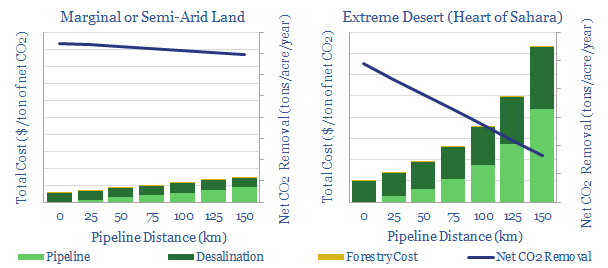Forests can offset 15bn ton of CO2 per year from 3bn global acres. But is there potential to afforest any of the world’s 11bn acres of arid and semi-arid lands, by desalinating and distributing seawater? Our 18-page note answers this question. While the energy economics do not work in the most extreme deserts (e.g., the Sahara), $60-120/ton CO2 prices may be sufficient in semi-arid climates, while the best economics of all use waste water from oil and gas, such as in the Permian basin.
The opportunity and challenges for nature based solutions to climate change are outlined on pages 2-4, explaining the rationale for afforesting deserts.
Precedents for afforesting deserts, including detailed case studies from the Academic literature, are reviewed on pages 5-8.
Water requirements are quantified, based on data from 60 tree species and the forestry industry, on pages 9-10.
The energy economics of desalinating and piping water are presented on pages 11-12.
The challenges of afforestation in the most extreme desert environments are modelled on page 13, showing why it is almost impossible to grow forests in the Sahara. The CO2 costs of supplying sufficient water could exceed the CO2 absorbed by new trees.
Supplementing rainfall in marginal lands is a more compelling economic model (e.g., adding the equivalent of 100mm new rainfall to marginal lands with c300-400mm), as shown on page 14.
The best case we can find is to use Permian waste water. Costs of desalination could be lower than current costs of disposal, while Permian upstream operations on the reforested acreage could be made carbon neutral, per pages 16-17.
A short list of companies exposed to the theme is presented on page 18.
